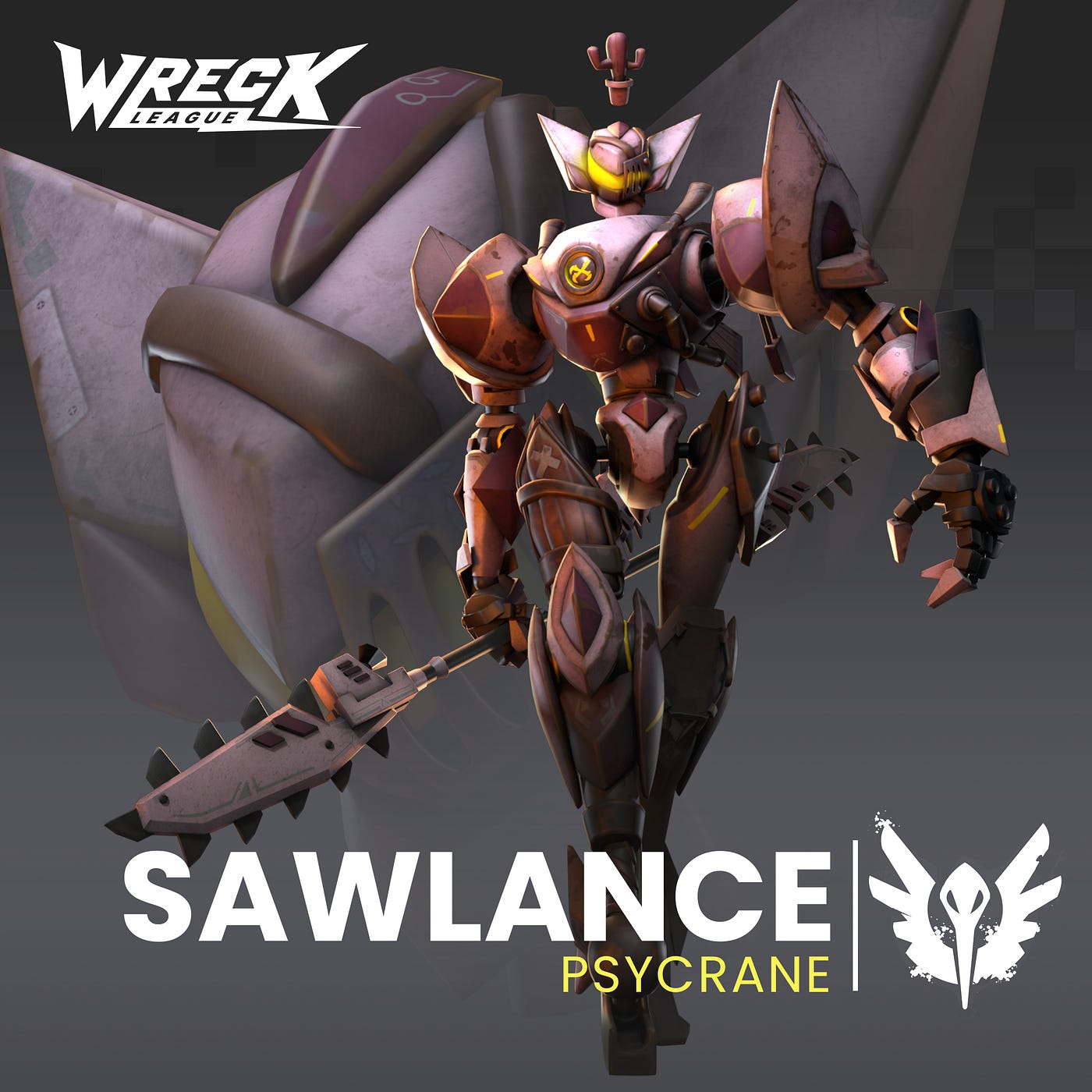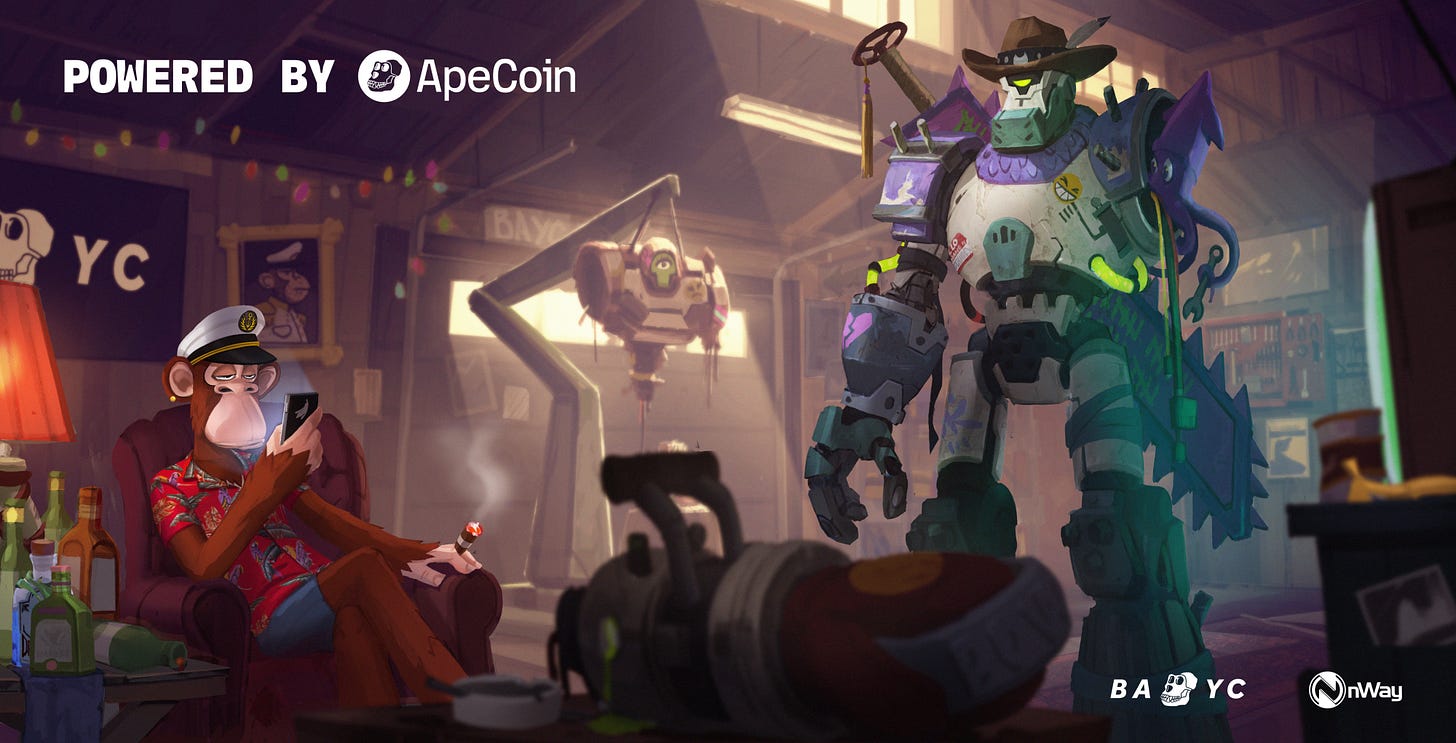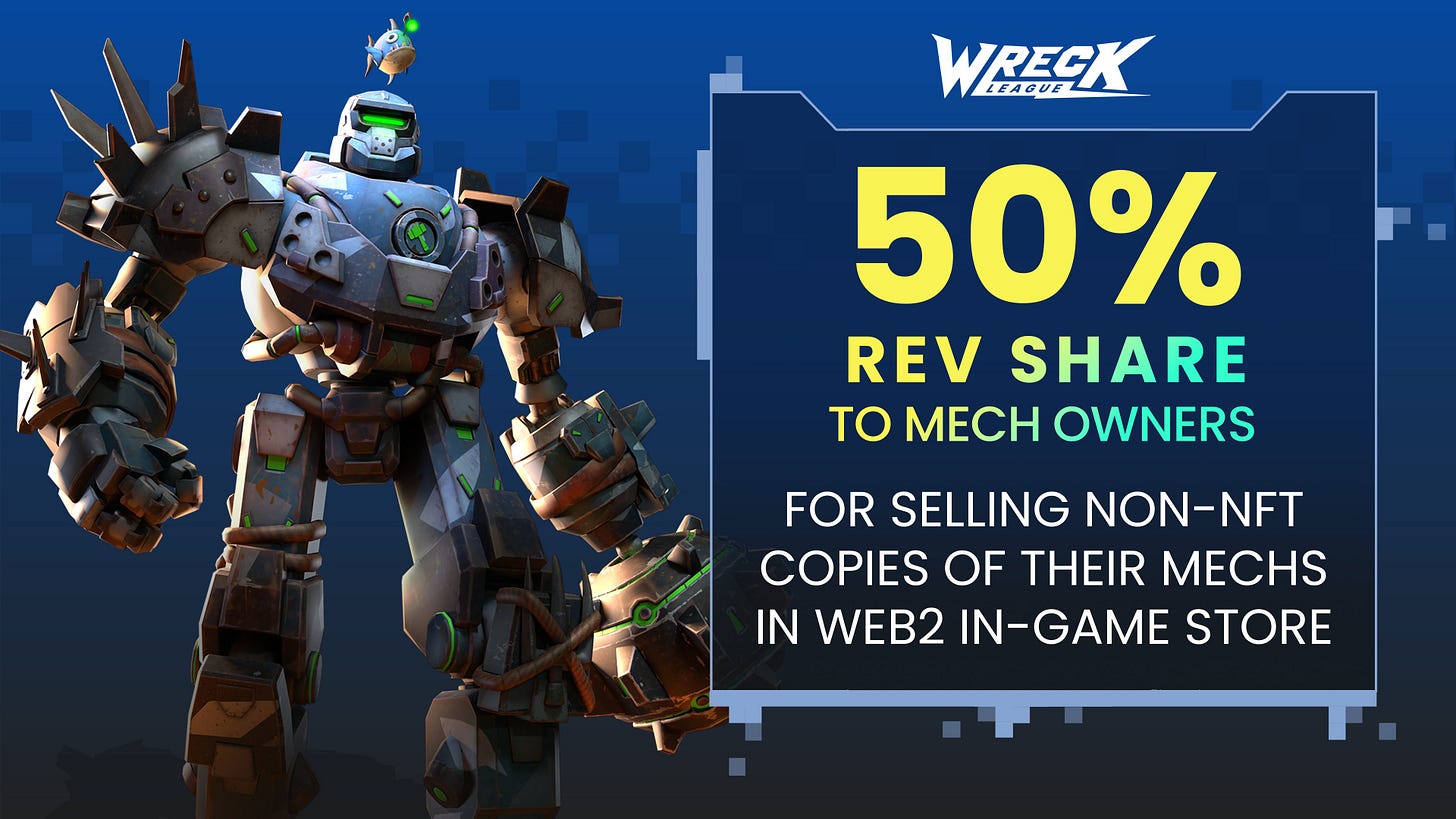The Wolves DAO Files #21: Wreck League's IAP - NFT Monetization Model.
The pitfalls of this strategy and why Mech holders will likely be dissapointed.
Wreck League: The Game
Wreck League (WL) is a recently launched PvP Mech combat game, hitting the gaming scene in early August, courtesy of nWay, a subsidiary of Animoca Brands. nWay boasts prior experience and success in the fighting game genre, notably with their title "Power Rangers: Legacy Wars."
Their venture into another title within this niche gaming sector aligns with their established expertise. However, it's worth noting that PvP fighting games occupy a relatively niche space in the gaming world, with a few standout successes primarily bolstered by strong IPs.
Super Smash Bros includes all the Nintendo characters
Street Fighter and Mortal Combat have established provenance
Dragon Ball Z is a large franchise
Similarly, the Power Rangers franchise is far from insignificant.
What set these fighting games apart and fueled their success was a lineup of distinct and captivating characters. In contrast, Wreck League adopts a Mech art style, which can sometimes make it challenging for players to differentiate between characters, hindering the establishment of a strong emotional connection.
Moreover, in Wreck League, fighters are crafted from a combination of ten distinct (NFT) parts. Builds impact their statistics and abilities, introducing a wholly new dimension of strategy and complexity to the meta-game. Standing as a clear distinguishing feature from conventional fighting games.
Casual Friendly
The genre traditionally caters to a smaller, niche audience due to its intricate game mechanics, often presenting a steep learning curve that can deter casual players. Wreck League, however, takes a different approach by simplifying the experience through the implementation of a straightforward energy system for skill activation, achievable with a single button press. The game's cross-platform compatibility, designed to seamlessly function on both PC and mobile devices, underscores its commitment to accessibility from the outset.
Overall, Wreck League distinguishes itself in this genre by introducing more user-friendly deckbuilding and RPG elements, optimizing its design for mobile play, and embracing a more casual-friendly approach, thereby widening its appeal beyond the traditional PvP fighting game audience.
Season 1: Yuga Labs Partnership
In the Wreck League announcement, the game unveiled a strategic partnership with Yuga Labs. This collaboration will bring four Yuga-themed collections—Kodas, Bored Apes, Bored Mutant Apes, and Bored Ape Kennel Club—into the game through three separate minting phases. Additionally, ApeCoin will integrate into the game's ecosystem, serving purposes such as minting and facilitating various in-game actions.
Monetization Model
Currently, Wreck League plans to employ monetization across three distinct levels, which encompass:
NFT sales + Royalties
In-app purchases (IAPs)
Web3 esports
1. NFT Sales + Royalties
The initial revenue stream for Wreck League revolves around NFT sales and associated royalties. In August, nWay conducted a sale of 25,000 'Wreck League Majestics' boxes, each priced at 150 APE. These boxes contained 10 NFT parts and one Founders Mech. Additionally, there were 5,000 'Booster Boxes' available for purchase, priced at 50 APE each, with each box containing 5 parts.
Despite the partnership with Yuga Labs, which boasts a substantial community with significant liquidity, the NFT sales did not meet expectations.
Wreck League Majestic Boxes sales: 8,990/25,000 (35.6% sold)
Booster Boxes sales: 3079/5,000 (61.6% sold)
However, buyers took comfort in the fact that the remaining supply had been burned during the mint, effectively preventing any further downward pressure on sales.
NFT Revenue Calculation
Majestic Boxes: 8,990 x 150 APE = 1.348.500
Booster Boxes: 3079 x 50 APE = 153.950
Ape Coin price 18-9-2023: $1.72
Gross revenue NFT sales: ~$2,584M
Royalties (since the NFT sale): ~$45K
IP Collaborations
In an interview with Blockchaingamer.biz, nWay's CEO revealed plans to collaborate with various IPs in the future. This strategy appears to be a smart approach to engage diverse communities and potentially attract them as buyers in upcoming branded NFT sales.

2. IAP Revenue
In the context of Web3 business models, Wreck League introduces an inventive approach to collaborative value creation between studios and players. As mentioned earlier, the game utilizes a crafting system that involves assembling ten NFT parts to create an NFT Mech. Those who own these assets can sell them in the free-to-play (F2P) version of the game, with a revenue share of 50%.
3.Web3 Esports
The game's third avenue for monetization centers around Web3 esports. nWay's ambition is to establish a "League" reminiscent of professional sports, where various franchises emerge within the overarching brand.

The CEO of nWay illustrates this vision for Wreck League by seeing players/holders not only participate but also organize and manage tournaments, including setting entry fees. A portion of these entry fees would then be allocated to the arena holder, creating a diverse ecosystem of stakeholders. While nWay's precise role in this value creation model remains unclear, it's conceivable that it could involve licensing or franchise fees, thus capturing a share of the overall value chain.
The IAP - NFT Revenue Share Model
In this week's question of the week, the Wolves set their sights on the intriguing monetization model of Wreck League, eager to delve deeper into its potential outcomes.
It's worth noting that we currently possess only partial information regarding the precise nature of Wreck League's monetization strategy.
Marketing Perspective
Members initially responded to the 50% revenue-sharing model perceiving it as notably generous. Some speculated that it might be a strategic marketing move designed to resonate with the aspirations of the Web3 community. In an industry characterized by a substantial presence of investors, the 50% revenue share could imply or insinuate that Wreck League presents an avenue for potential (passive) financial gain.
The 50% cut is perfect from a UX perspective. Something sells for $5, you get $2.5. The theoretical max here is more or less 70%, which I think in some ways sounds less attractive.
Revenue Perspective
When examining the revenue implications, the substantial revenue share becomes a distinct aspect to consider, especially given that the studio only retains 20% of each IAP (calculated as 100% - 50% - 30% app store fee). It's worth highlighting that two members, both with considerable expertise in this area, expressed differing viewpoints.
At this stage, it's impossible to say what the balance in the monetization will be between selling NFTs. royalties and IAPs, but it's obvious that the F2P is the bigger group, and therefore IAPs might be where the revenue is supposed to be mostly coming from.
The 20% for the dev is peanuts and fairly irrelevant. There is no way they plan for this to be their primary money maker. Could probably just as well be 10% or 5% without a huge impact on the overall business case.
The initial quote raises a valid concern regarding the current lack of clarity surrounding the monetization balance. However, other members highlighted, that a critical factor for this model to succeed as a primary revenue driver is the need for a substantial number of free-to-play (F2P) players.
However, even with a solid > 2 % purchasing user conversion within the F2P player cohort, the amount of F2P players compared to those creating the NFTs needs to be huge, or those making the NFTs will leave.
In essence, this revenue-sharing model poses a considerable challenge for Wreck League in terms of achieving sustainable scalability to attract the required high user volume. To address this, they may need to find a balance, possibly by optimizing the NFT side or exploring alternative revenue avenues.
Interestingly, this approach mirrors the economies of successful free-to-play (F2P) mobile games, which heavily rely on high-spending players known as "whales." In this context, Web3 investors wield similar economic influence. Notably, this approach appears to cater even more toward high-value players, as the monetization model is less favorable to generate revenue from free-to-play users, likely to make it more appealing to the Web3 community.
Player (Investor) Perspective
As previously discussed, Wreck League's monetization structure suggests the possibility for players to establish a (passive) income stream. Nevertheless, concerns have arisen about whether this model, which has potential drawbacks, could ultimately disappoint players.
The initial concern centers around the game's crafting mechanics, where assembling one Mech necessitates collecting ten body parts, with a significant number of available parts resulting in almost infinite variations.
But with basically an infinite number of combinations, very few mechs would be purchased in the store. Only those tuned into the game and creating meta mechs will do any volume and only if they are priced appropriately (not sure if the price is set by the mech owner or standard pricing set by the studio.
nWay's strategy introduces considerable challenges in terms of differentiation, with only those players who thoroughly analyze the game's meta, particularly the most effective builds, standing to gain significantly. The advantage is likely to be limited to a relatively small subset of players.
Moreover, the focus on in-app purchases (IAPs) primarily involves microtransactions, implying that players' revenue opportunities within the game will probably remain modest unless there's a substantial and widespread free-to-play (F2P) player base.
50% sounds great on paper but 50% of 3 sales a year is a pretty insignificant rev share. Most NFT holders will be disappointed imo.
Finally, given the studio's intention to introduce new intellectual properties (IPs) in each game season, along with new Mech parts, the already vast number of variations is bound to expand. Consequently, NFT holders may find themselves needing to assemble NFTs using the latest parts to maintain relevance across a wide array of Mechs.
In a post on X, Hunter Solaire expressed a similar perspective after engaging with the game firsthand.
Pushing the Boundaries of Web3 Economies
Despite the challenges associated with the NFT-IAP model, Wreck League is undoubtedly pushing the boundaries of the Web3 monetization model. It exemplifies an incentive alignment where players and nWay are closely linked in terms of value creation and accrual. However, an improved model could lead to a scenario where both parties can benefit equally from the growth of Wreck League, fostering a sense of shared success.
Furthermore, nWay's ambition to establish a Web3 esports model, essentially a financial metagame driven by players and stakeholders, is an intriguing aspect to watch develop. This aligns with the ethos of Web3 and the core gameplay of Wreck League, which inherently supports the creation of a league model atop the game.
Here it seems to be done by having players constantly focused on inventory management and other managerial gameplay, as opposed to "just fighting".
Both of these monetization models establish an incentive structure that encourages players to promote their assets, tournaments, arenas, or any other stake they have in the game, thereby stimulating the game's adoption.
Improving the model
While Wreck League's current monetization strategies are seen as unsustainable, the underlying concept appears promising. Instead of allowing all Mechs to be sold as IAPs, the studio could consider a model that rents out a limited number of licensing fees with expiration dates. In this concept, other players can still experiment with Mechs and try different builds, but only a select group of holders can sell their NFTs as IAPs.
The outcome is a less crowded market, making this revenue opportunity more significant from the player's perspective. It also ensures an optimized roster (up-to-date with the meta) for F2P players. Over time, these licenses would gradually transfer to the most active players or holders interested in collaborating with highly competitive ones.
Another avenue to explore is awarding licenses to the top 250 best-performing players each season, adding an engaging incentive to the overall game.
Similarly, a more sustainable model for value creation is discussed in the following quote.
Well, imagine a game with cosmetics like Eve Online. This game already has ship skins and localized markets. However, take this a step further and make it so that player-driven markets also have unique ship skins that you can only buy from that market.
But how do players/studios monetize this fairly?
Initial exploration is that a studio would sell the "Cosmetic Plan" to players in a limited quantity and when the player purchases it, they now have exclusive rights to that cosmetic.
It's currently unclear whether Wreck League plans to IAPs directly, potentially taking a 70% revenue share from these sales. If the studio decides to offer basic or common Mech parts as IAPs while allowing NFT holders to sell complete Mechs, this approach could help balance the loss from the Mech NFT revenue split to some extent.
Conclusion
Wreck League's monetization model includes three pillars encompassing NFT sales, royalties, IAP sales, and Web3 esports. The game's innovative approach to collaborative value creation between studios and players through IAPs is intriguing. However, it poses challenges in terms of market saturation and differentiation. The revenue-sharing model, offering NFT holders a 50% share, has garnered attention for its potential marketing appeal but also raises concerns about sustainability, particularly the need for a substantial F2P player base.
Wreck League is undeniably pushing the boundaries of the Web3 monetization model, aligning player and studio incentives. Its vision for Web3 esports, driven by players and stakeholders, adds an exciting dimension. To improve sustainability, the studio could explore models including limited licensing fees with expiration dates or awarding licenses to top-performing players. Despite the challenges, Wreck League represents an innovative attempt to foster shared success within the Web3 gaming ecosystem, albeit with room for refinement and adaptation as it continues to evolve.
Special Thanks To
AmberBella, Creedx, TomM, Lemz, Marklar, Zapdan Riddler2, Eetherway, TimoYouth, Arto, H2BT, StoicJay, and Steps for actively contributing to this discussion and providing valuable insights.
This Substack post was put together by @Web3_Memento.
Need Help?
Need market intel and advice to help your Web3 project succeed? Get in touch with The Wolves today and receive a free consultation!
Disclaimer
None of this is financial or legal advice.













